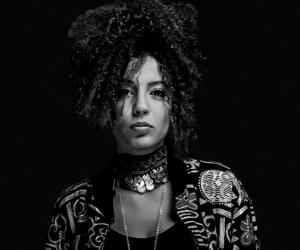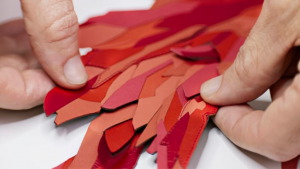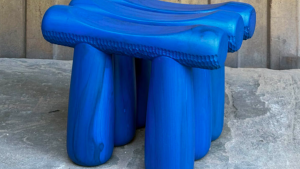From the Series
Egyptian fashion designer, Amna Elshandaweely, took to the stage at Design Indaba today not only to speak about her career and background but to also launch a new Afropunk inspired fashion range, which she presented in a fashion show.
She spoke about one of the most isolated settlements in Egypt, about 600 kilometres from Cairo, the women of Siwa or the Amazigh spend up to ten years working on their wedding dresses.
The ethnic group, indigenous to North Africa but found in many parts of the continent, are known around the world for their elaborate textile traditions (check Berber weddings on Pinterest). But their culture is still relatively unknown.
Elshandaweely travels to places like Siwa as part of her exploration into what it means to be an Egyptian and deeper still, what it means to be African.
“Everytime I travelled around Africa my friends were like: ‘Are you going to Africa?’,” she says jokingly. “Like they don’t consider Egypt as part of Africa.”
In the same way, Egyptian society doesn’t consider dark-skinned Egyptian women to be beautiful, explains Elshandaweely.
“When I went to Kenya, I was really inspired by the Kenyan women and how they change their looks and look really nice." She says that although there are dark skinned people in Egypt, like the Nubian people from Luxor or Aswan, they are not considered to be as beautiful as lighter skinned Egyptians.
"They have the facial features of the pharaohs, ya’aani,” she says in frustration, before breaking into a smile.
As a dark-skinned woman herself, Elshandaweely has had to deal with the prejudices of colourism in society and in the media. It’s lighter skin and lighter shades of fabric that people consider beautiful, trendy and chic.
“I’ve always had darker skin than a lot of Egyptians and I have curly hair. So every time I walk in the street I always receive comments. It’s either in a funny way or let’s say, just a not funny way,” she explains.
“People consider white girls who have straight hair as beautiful, fa, when I was growing up I started by looking around the world, not just here in Egypt, and I found that there is beauty, ya’aani, in dark skin.”
With her eponymous tribal wear brand and her exploration of African identity, she’s looking to challenge this norm. In one of her earlier ranges, Road to Fayuom, she did something as simple as using dark-skinned models in her catalogues. The aim was to give dark-skinned Egyptians a chance to see themselves represented not only in the models but in the range itself.
“Models are always people you look for and what to be like, so a lot of people seeing darker skinned models, it was very interesting and it was actually shocking for a lot of people here in Egypt,” she adds.
Road to Fayoum was inspired by the Egyptian city it’s named after. Its green landscapes and Islamic architecture make it a welcome respite from the smoke, concrete and hustle of the country’s capital.
Elshandaweely’s fashion line celebrated Fayoum for its uniqueness. In an earlier interview, Elshandaweely said the pair chose colours that could take the wearer out of Cairo and make them feel as though they’re spending spring in Fayoum.
Unlike traditional ranges, their line was not targeted at any gender or age, making the pieces versatile and inclusive in a way that the Egyptian fashion scene could appreciate.
The line garnered a lot of attention (Elshandaweely was later featured on Project Runway) and the designer set out to take advantage of that momentum. Her next range, the Amazigh, was a similar exploration of place and people, one where she also drew on the differences she found between the people in Cairo and the people of the old cities.
“They have the same language so a lot of people here they don’t understand them,” she explains. “They have their own way of dressing up, their own way of music and different heritage.”
“I was fascinated by how different the people were. I read about them and I read about their culture; I found out they exist all over the world.”
Her tribal fashion ranges are available at her store Galleria40 in Giza and she also sells from her Facebook page, which has over 21 000 followers from all over the world.
But the road was not easy, she recalls. Before the Egyptian revolution, Elshandaweely sought security in a well-paying publishing and marketing position. But when the masses took to the streets, she found a community of creatives that still work to prop one another up.
“I believe that without the revolution I wouldn’t have been the person I am today,” she says, adding that even though it played such a big role in her choices then, it’s challenging to not be disheartened in the aftermath of the uprising that has left its citizens exhausted.
“I feel like we don’t have the same energy we used to have. Back then it was very inspiring and we felt like everything is going to change. Right now, a lot of people feel like it’s changed for the worse. For me, it was an experience that added value to a lot of people.
Us as young people, we believed in tomorrow.”
In the future, Elshandaweely hopes to keep exploring Africa, using the creative industry to bridge the gaps between country, identity, tradition and politics.












